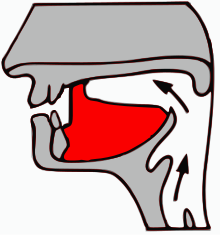Retroflex consonant
This article needs additional citations for verification. (August 2020) |
| Retroflex | |
|---|---|
| ◌̢ | |
| ◌̣ |

A retroflex, apico-domal, or cacuminal (/kæˈkjuːmɪnəl/) consonant is a coronal consonant where the tongue has a flat, concave, or even curled shape, and is articulated between the alveolar ridge and the hard palate. They are sometimes referred to as cerebral consonants—especially in Indology.
The Latin-derived word retroflex means "bent back"; some retroflex consonants are pronounced with the tongue fully curled back so that articulation involves the underside of the tongue tip (subapical). These sounds are sometimes described as "true" retroflex consonants. However, retroflexes are commonly taken to include other consonants having a similar place of articulation without such extreme curling of the tongue; these may be articulated with the tongue tip (apical) or the tongue blade (laminal).
Types[]
Retroflex consonants, like other coronal consonants, come in several varieties, depending on the shape of the tongue. The tongue may be either flat or concave, or even with the tip curled back. The point of contact on the tongue may be with the tip (apical), with the blade (laminal), or with the underside of the tongue (subapical). The point of contact on the roof of the mouth may be with the alveolar ridge (alveolar), the area behind the alveolar ridge (postalveolar), or the hard palate (palatal). Finally, both sibilant (fricative or affricate) and nonsibilant (stop, nasal, lateral, rhotic) consonants can have a retroflex articulation.
The greatest variety of combinations occurs with sibilants, because for them, small changes in tongue shape and position cause significant changes in the resulting sound. Retroflex sounds generally have a duller, lower-pitched sound than other alveolar or postalveolar consonants, especially the grooved alveolar sibilants. The farther back the point of contact with the roof of the mouth, the more concave is the shape of the tongue, and the duller (lower pitched) is the sound, with subapical consonants being the most extreme.
The main combinations normally observed are:
- Laminal post-alveolar, with a flat tongue. These occur, for example, in Polish cz, sz, ż (rz), dż .
- Apical post-alveolar, with a somewhat concave tongue. These occur, for example, in Mandarin zh, ch, sh, r, Hindi and other Indo-Aryan languages. (Hindi has no retroflex sibilants, unlike some of the other Indo-Aryan languages.)[1][2]
- Subapical palatal, with a highly concave tongue, which occur particularly in the Dravidian languages and some Indo-Aryan languages. They are the dullest and lowest-pitched type and, after a vowel, often add strong r-coloring to the vowel and sound as if an American English r occurred between the vowel and consonant. They are not a place of articulation, as the IPA chart implies, but a shape of the tongue analogous to laminal and apical.[3]
Subapical sounds are sometimes called "true retroflex" because of the curled-back shape of the tongue, and the other sounds sometimes go by other names. For example, Ladefoged and Maddieson[4] prefer to call the laminal post-alveolar sounds "flat post-alveolar".
Other sounds[]
Retroflex sounds must be distinguished from other consonants made in the same parts of the mouth:
- the palato-alveolar consonants (e.g. [ʃ ʒ]), such as the sh, ch and zh occurring in English words like ship, chip and vision
- the alveolo-palatal consonants (e.g. [ɕ ʑ]), such as the j, q and x occurring in Mandarin Chinese
- the dorsal palatal consonants (e.g. [ç ʝ ɲ]), such as the ch [ç] in German ich or the ñ [ɲ] in Spanish año
- the grooved alveolar consonants (e.g. [s z]), such as the s and z occurring in English words like sip and zip
The first three types of sounds above have a convex tongue shape, which gives them an additional secondary articulation of palatalization. The last type has a groove running down the center line of the tongue, which gives it a strong hissing quality. The retroflex sounds, however, have a flat or concave shape, with no associated palatalization, and no groove running down the tongue. The term "retroflex", in fact, literally means "bent back" (concave), although consonants with a flat tongue shape are commonly considered retroflex as well.
Transcription[]
IPA transcription[]
In the International Phonetic Alphabet, the symbols for retroflex consonants are typically the same as for the alveolar consonants, but with the addition of a right-facing hook to the bottom of the symbol.
Retroflex consonants are transcribed in the International Phonetic Alphabet as follows:
| IPA | Description | Example | |||
|---|---|---|---|---|---|
| Language | Orthography | IPA | Meaning | ||
| ɳ | voiced retroflex nasal | Punjabi | ਗਾਣਾ / گاݨا | [ˈgaːɳaˑ] | song |
| ʈ | voiceless retroflex plosive | Swedish | parti | [pʰaˈʈiː] | party |
| Hindi / Urdu | टापू / ٹاپُو | [ʈaːpuˑ] | island | ||
| ɖ | voiced retroflex plosive | Swedish | nord | [nuːɖ] | north |
| Hindi / Urdu | डब्बा / ڈبہ | [ɖəbba] | box | ||
| ʂ | voiceless retroflex fricative | Mandarin | 上海 (Shànghǎi) | [ʂɑ̂ŋ.xàɪ] | Shanghai |
| Sanskrit | भाषा | [bʱɑːʂɑː] | language | ||
| ʐ | voiced retroflex fricative | Russian | жаба | [ˈʐabə] | toad |
| Polish | żaba | [ˈʐaba] | frog | ||
| ɻ | voiced retroflex approximant | Tamil | தமிழ் | [t̪ɐmɨɻ] | Tamil |
| ɭ | voiced retroflex lateral approximant | Marathi | बाळ | [ˈbɑːɭ] | baby |
| Swedish | Karlstad | [ˈkʰɑːɭ.sta] | Karlstad | ||
| ɽ | voiced retroflex flap | Hausa | shaara | [ʃáːɽa] | sweeping |
| Hindi / Urdu | कीचड़ / کیچڑ | [kiːt͡ʃəɽ] | mud | ||